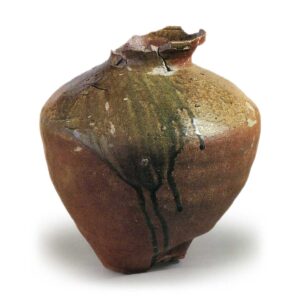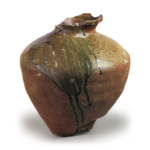
Excavated in Fukui Pref.
13th century
Height 38.0cm, Body diameter 36.0cm
Mizuno Museum of Antique Ceramics
Although regrettably about half of the neck of this vase is missing, it is not too much to say that this is one of the best Echizen large vases of the Kamakura period (1185-1333). It is made of high-quality clay with relatively low sand content for Echizen pottery. The well-fired red surface is covered with a rich dark green natural glaze from the mouth rim to the shoulder, part of which flows down to the lower half of the body, adding a scenic touch. The shape is reminiscent of a Tokoname vase, but the small, narrow neck and the band around the mouth rim are unique to Echizen. The cross-shaped inscriptions on the shoulder are also characteristic of Echizen vases. The strong tension of the shoulders, the shape of the mouth rim, and the shape of the base, which is small in comparison to its size, suggest a date of production around the middle of the Kamakura period (1185-1333). It may be said that this is an early piece that started out in Tokoname and began to show the characteristics of Echizen.








